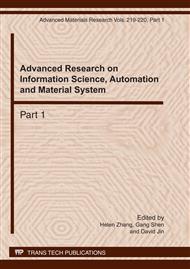[1]
Rao, G.A., and Mahulikar, S.P.: Integrated review of stealth technology and its role in airpower,, Aeronautical Journal., 2002, 106, (1066), pp.629-641.
DOI: 10.1017/s0001924000011702
Google Scholar
[2]
Men, X.S., Tian, X.H., and Gong, J.: Study on the capability of near space bistatic radar in detecting stealth targets,, Electronics Optics & Control., 2009, 16,(5), pp.43-6.
Google Scholar
[3]
Jian, J.L., Ren, H.B., and Gao, F.: A preliminary research into the netted radar seekers for anti-stealth aircraft,. 4th. Proc. Int. Conf. Signal Process, China, OCT 1998, pp.1566-1569.
DOI: 10.1109/icosp.1998.770925
Google Scholar
[4]
Mei, Y.: Research on DS-SS applying to anti-interference technique,. DE thesis, National University of Defense Technology China, (2008).
Google Scholar
[5]
Gross, F.B., and Chen, K.: Comparison of detectability of traditional pulsed and spread spectrum radar waveforms in classic passive receivers,, IEEE Transactions on Aerospace and Electronic Systems., 2005, 41, (2), pp.746-751.
DOI: 10.1109/taes.2005.1468765
Google Scholar
[6]
Yang, T.C., and Yang, W.B.: Low probability of detection underwater acoustic communications using direct-sequence spread spectrum,, Journ of the Acoustical Society of America., 2008, 124, (6), pp.3632-3647.
DOI: 10.1121/1.2996329
Google Scholar
[7]
Gross, FB., and Chen, K.: Comparison of detectability of traditional pulsed and spread spectrum radar waveforms in classic passive receivers,, IEEE Transactions on Aerospace and Electronic Systems., 2005, 41, (2), pp.746-751.
DOI: 10.1109/taes.2005.1468765
Google Scholar
[8]
Horvath, M., Seller, R., and Rosner, V.: Synthetic Aperture Radar using spread spectrum modulation,. 19th Int. Conf. Radioelektronika, Bratislava, SLOVAKIA, 2009, pp.149-152.
DOI: 10.1109/radioelek.2009.5158784
Google Scholar
[9]
Harmuth, HF.: Radio Signals with Large Relative Bandwidth for over-horizon Radar and spread-spectrum communications,, IEEE Transactions on Electromagnetic Compatibility., 1978, 20, (4), pp.501-512.
DOI: 10.1109/temc.1978.303630
Google Scholar


